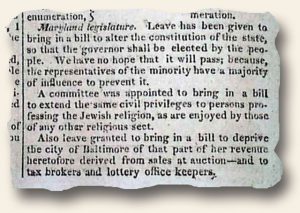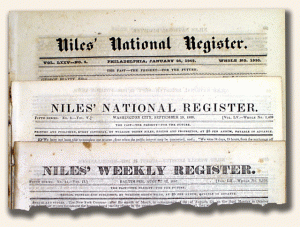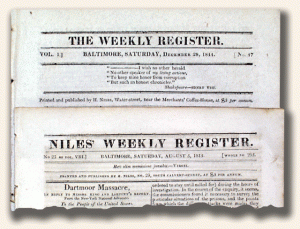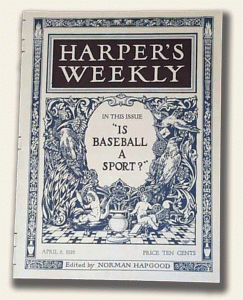Equal rights – a long and arduous path…
May 6, 2019 by GuyHeilenman · Leave a Comment
“Equal Rights” – Within the United States, it is easy to think the struggle for equality based on race, gender and/or socioeconomic status was, and in certain areas continues to be, one placed on the shoulders of only Blacks and Women. However, it doesn’t take too much digging to see this was not the case. I was reminded of this reality when I recently came across a December 19, 1818 issue of the Niles’ Weekly Register. Therein I found a heading titled “Maryland legislature,” which included in part, “…A committee was appointed to bring in a bill to extend the same civil privileges to persons professing the Jewish religion as are enjoyed by those of any other religious sect…”.
 As a bit of history, In 1776 Maryland’s constitution safely protected “…all persons professing the Christian religion…” yet said nothing at all for those of other beliefs. It was a fact not widely known among other Americans that in the State of Maryland, and in Maryland alone, a citizen professing the Jewish religion could not hold any office, civil or military. In 1797 Solomon Etting, Baltimore leader and representative Jewish figure, along with other prominent Jews petitioned the Maryland Assembly to address this prejudicial issue and secure equal rights for Jews. The petition was well received but ultimately rejected. Year after year as it was presented and turned down new advocates were enlisted including influential Gentiles. In 1818 Judge H. M. Brackenridge and others began a vigorous battle to right this wrong. The legislation ultimately to be known as “The Jew Bill” was enfranchised in 1825 and confirmed the following year. This change, along with a series of others, helped motivate many Jewish citizens to participate, from a position of privilege, in the early suffrage movement.
As a bit of history, In 1776 Maryland’s constitution safely protected “…all persons professing the Christian religion…” yet said nothing at all for those of other beliefs. It was a fact not widely known among other Americans that in the State of Maryland, and in Maryland alone, a citizen professing the Jewish religion could not hold any office, civil or military. In 1797 Solomon Etting, Baltimore leader and representative Jewish figure, along with other prominent Jews petitioned the Maryland Assembly to address this prejudicial issue and secure equal rights for Jews. The petition was well received but ultimately rejected. Year after year as it was presented and turned down new advocates were enlisted including influential Gentiles. In 1818 Judge H. M. Brackenridge and others began a vigorous battle to right this wrong. The legislation ultimately to be known as “The Jew Bill” was enfranchised in 1825 and confirmed the following year. This change, along with a series of others, helped motivate many Jewish citizens to participate, from a position of privilege, in the early suffrage movement.
Regarding State and National Constitutions… Our fore(parents) may not have gotten everything right, but thankfully, in most cases, they had the foresight to created peaceful paths for change. Peaceful progress, using the proper channels the framers built within these founding documents, may take entirely too long, but staying within the given bounds has served us well over time. There is, and will likely always be much to be done, but we live in a marvelous land of progress. Let’s never let the need for pruning and continued growth ever cause us to hack away at the roots.
The Traveler… a presidential nomination… a bit buggy…
May 21, 2012 by The Traveler · Leave a Comment
 Today’s travels took me to Baltimore, Maryland, through The Weekly Register (Niles”) of May 23, 1812. There I found the “Presidential Nomination” had occurred “…For JAMES MADISON, 82 — No other person being voted for… On motion of Mr. Campbell of Ten. it was then Resolved, As the sense of this meeting, that JAMES MADISON, of the state of Virginia, be recommended as a proper person to fill the office of President, for four years from the third day of March next:…”. Additional information is within that article as well as additional articles pertaining to “The Nomination” and “Presidential Election”.
Today’s travels took me to Baltimore, Maryland, through The Weekly Register (Niles”) of May 23, 1812. There I found the “Presidential Nomination” had occurred “…For JAMES MADISON, 82 — No other person being voted for… On motion of Mr. Campbell of Ten. it was then Resolved, As the sense of this meeting, that JAMES MADISON, of the state of Virginia, be recommended as a proper person to fill the office of President, for four years from the third day of March next:…”. Additional information is within that article as well as additional articles pertaining to “The Nomination” and “Presidential Election”.
“The Locusts of Africa” article is interesting as it states that that “…when they visit a country it behooves every individual to lay in a provision against a famine; for they are said to stay three, five, or seven years…”. I can’t begin to image dealing with those bugs for a portion of a day let alone for years!
~The Traveler
“New Series” of a newspaper…
September 7, 2009 by TimHughes · Leave a Comment
 A recent inquiry by a concerned customer about the words “fifth series” printed in the dateline of his “Niles’ National Register” prompted me to share my comments with our blog readers should you have similar concerns of such notes atop this and other titles held in your collection.
A recent inquiry by a concerned customer about the words “fifth series” printed in the dateline of his “Niles’ National Register” prompted me to share my comments with our blog readers should you have similar concerns of such notes atop this and other titles held in your collection.
Through the life of any newspaper which lasted beyond ten years it would not be uncommon for the title to change, either slightly or dramatically. This could happen for a number of reasons, such as the merging with another newspaper, the purchase of the paper by a new publisher, new city of publication, an altering in the size, theme, or format of the newspaper, etc. While some titles made no note of such changes in their volume and issue numbering, some chose to create a “new series” and start anew with the volume & issue numbering.
 “The Weekly Register“, which began in Baltimore, chose the latter. The photos show five of the title or location changes in a 38 year time spread, not to mention size and type font changes as well. Note that its location moved from Baltimore to “Washington City” to Philadelphia.
“The Weekly Register“, which began in Baltimore, chose the latter. The photos show five of the title or location changes in a 38 year time spread, not to mention size and type font changes as well. Note that its location moved from Baltimore to “Washington City” to Philadelphia.
Fortunately Niles chose to also retain the original volume numbering as well (right side of the dateline) as well as the “whole number”, or the number since the very first issue was published. Other titles did not choose to do so, making it more difficult to determine the newspaper’s age.
Why does my newspaper look as if it came from a book?
April 30, 2009 by GuyHeilenman · Leave a Comment
 This is a common question many newcomers ask upon their 1st encounter with a rare newspaper from nearly every era (Revolutionary War, Civil War, Old West, and even Birthday/Day-You-Were-Born issues, to name a few). Whether it is the rough left spine present from the issue being removed from a larger volume, or the consecutive numbering which results in only the first issue printed during the year to have a “page 1”, a novice’s immediate (and logical) reaction is that the issue must have come from a book and therefore must be a reprint. However, the truth is actually the opposite. Such signs are good indicators that the issue is likely authentic. To understand this, what is needed is a knowledge of how historic newspapers and magazines were handled up to as late as the 1960’s.
This is a common question many newcomers ask upon their 1st encounter with a rare newspaper from nearly every era (Revolutionary War, Civil War, Old West, and even Birthday/Day-You-Were-Born issues, to name a few). Whether it is the rough left spine present from the issue being removed from a larger volume, or the consecutive numbering which results in only the first issue printed during the year to have a “page 1”, a novice’s immediate (and logical) reaction is that the issue must have come from a book and therefore must be a reprint. However, the truth is actually the opposite. Such signs are good indicators that the issue is likely authentic. To understand this, what is needed is a knowledge of how historic newspapers and magazines were handled up to as late as the 1960’s.
 Many publishers of early newspapers started numbering their pages from 1 at the start the year and continued with the consecutive numbering throughout the year. This made it very easy to reference content. Examples of early well-known titles which did this are Harper’s Weekly, The War, Gentleman’s Magazine, Niles’ Register, and Leslie’s Illustrated, to name a few. Although this gave the newspapers a book effect, early readers would not have given this another thought. As far as the spine residue/disbinding evidence (which gives the appearance that the issue came from a book) is concerned, nearly every institution which held rare newspapers bound them together at the end of each year for protection & permanent storage in libraries. Almost all newspapers through the 1960’s were held in this manner. Your local library likely holds its early newspapers in this form. Two resources which may alleviate any concerns you might have related to this issue are the Library of Congress’ Newspaper Division & the American Antiquarian Society. HistoryBuff.com also provided additional information regarding this topic.
Many publishers of early newspapers started numbering their pages from 1 at the start the year and continued with the consecutive numbering throughout the year. This made it very easy to reference content. Examples of early well-known titles which did this are Harper’s Weekly, The War, Gentleman’s Magazine, Niles’ Register, and Leslie’s Illustrated, to name a few. Although this gave the newspapers a book effect, early readers would not have given this another thought. As far as the spine residue/disbinding evidence (which gives the appearance that the issue came from a book) is concerned, nearly every institution which held rare newspapers bound them together at the end of each year for protection & permanent storage in libraries. Almost all newspapers through the 1960’s were held in this manner. Your local library likely holds its early newspapers in this form. Two resources which may alleviate any concerns you might have related to this issue are the Library of Congress’ Newspaper Division & the American Antiquarian Society. HistoryBuff.com also provided additional information regarding this topic.


